









Martinet Lake - Jim Lake PGE - Cu - Ni - Au Potential Property
242 Cell Claim Units Available for Option
Pegmatite units on property and not explored for Lithium potential yet.

New Staked Cell Claim Units by Generation Mining on January 30, 2024 Outlined in Green
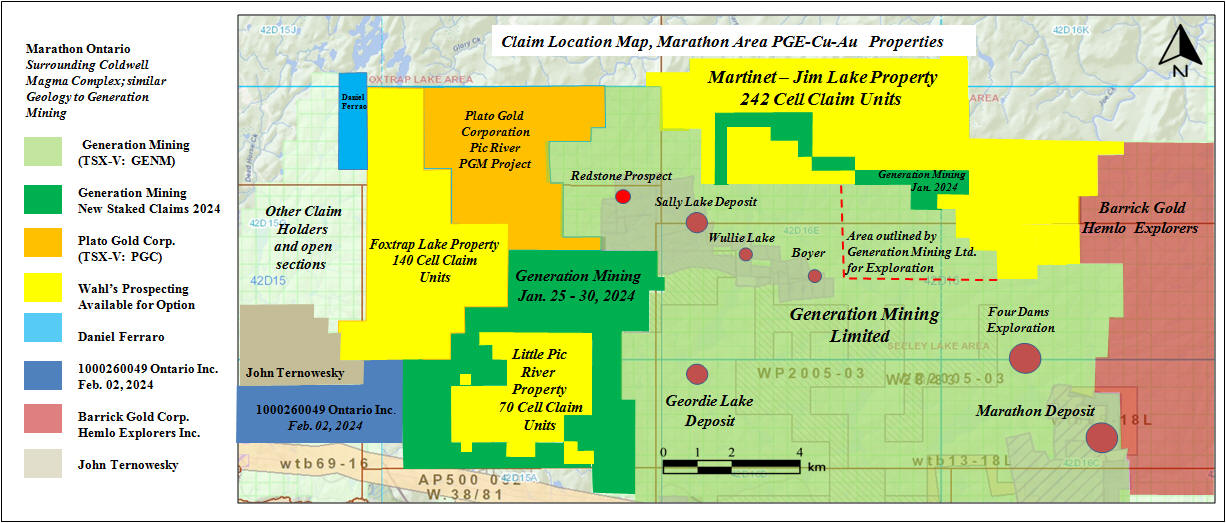
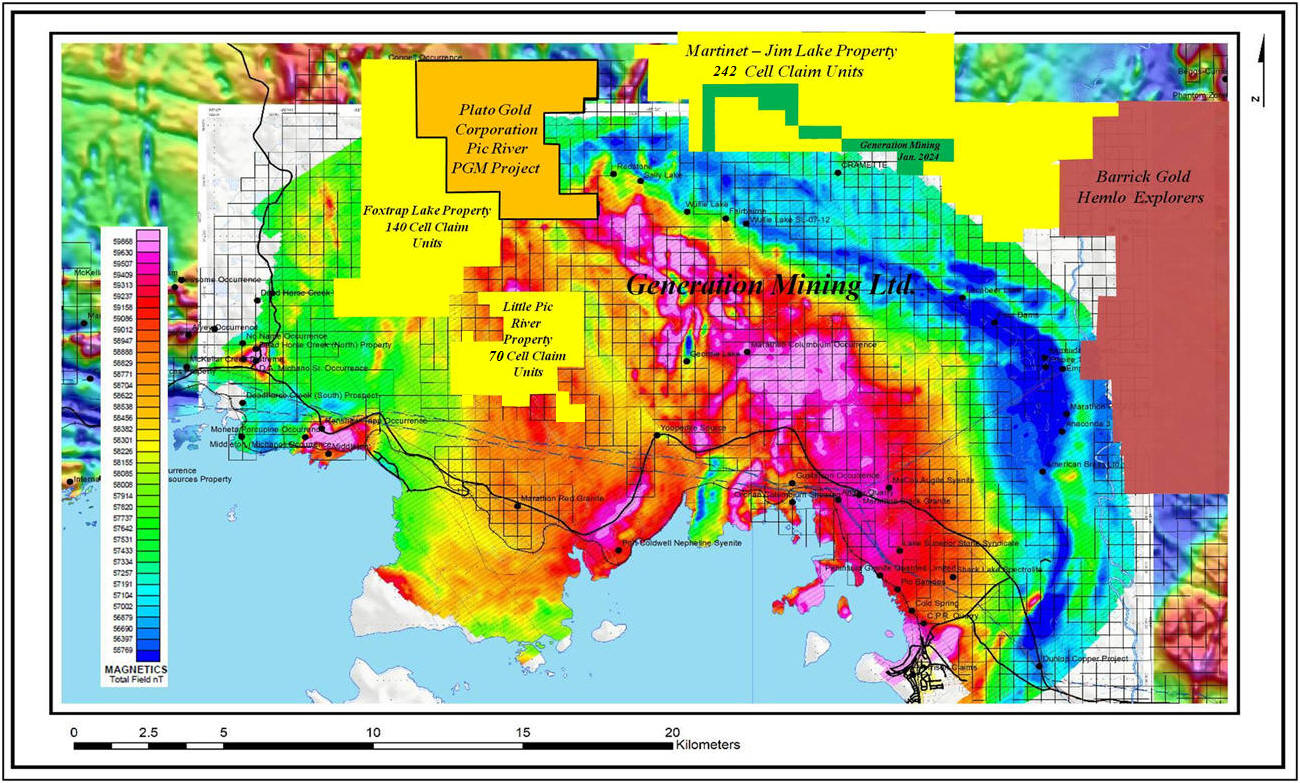
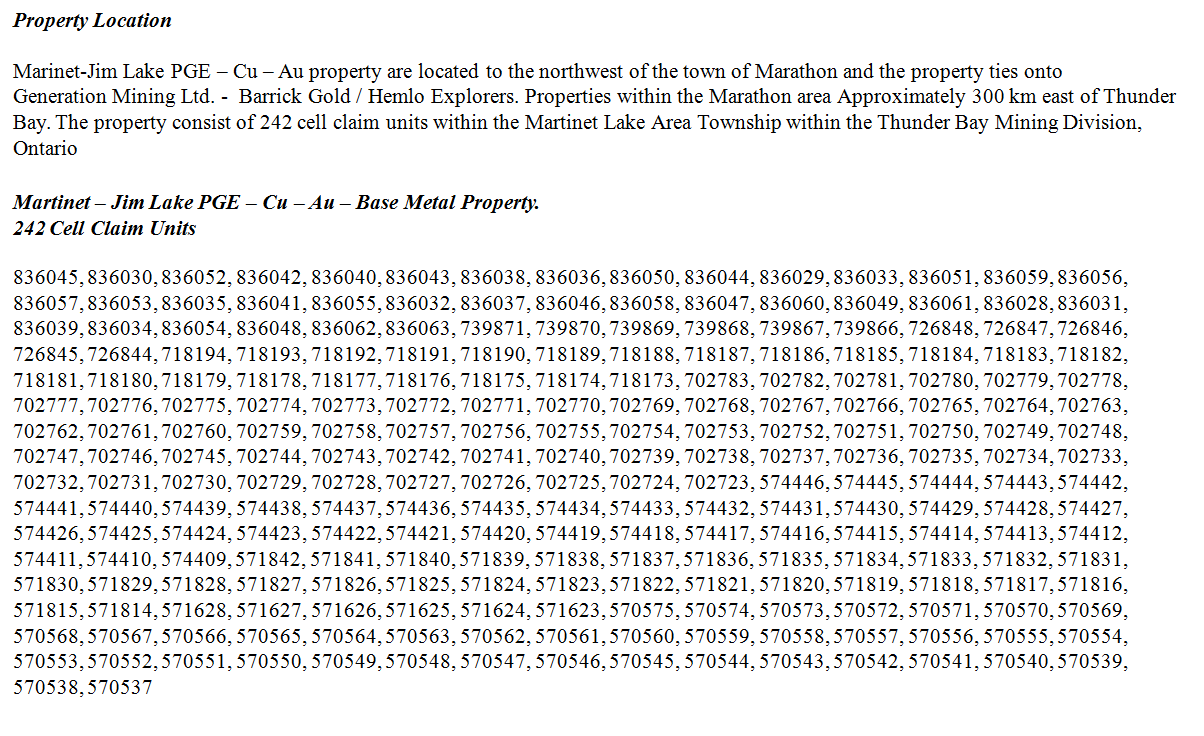
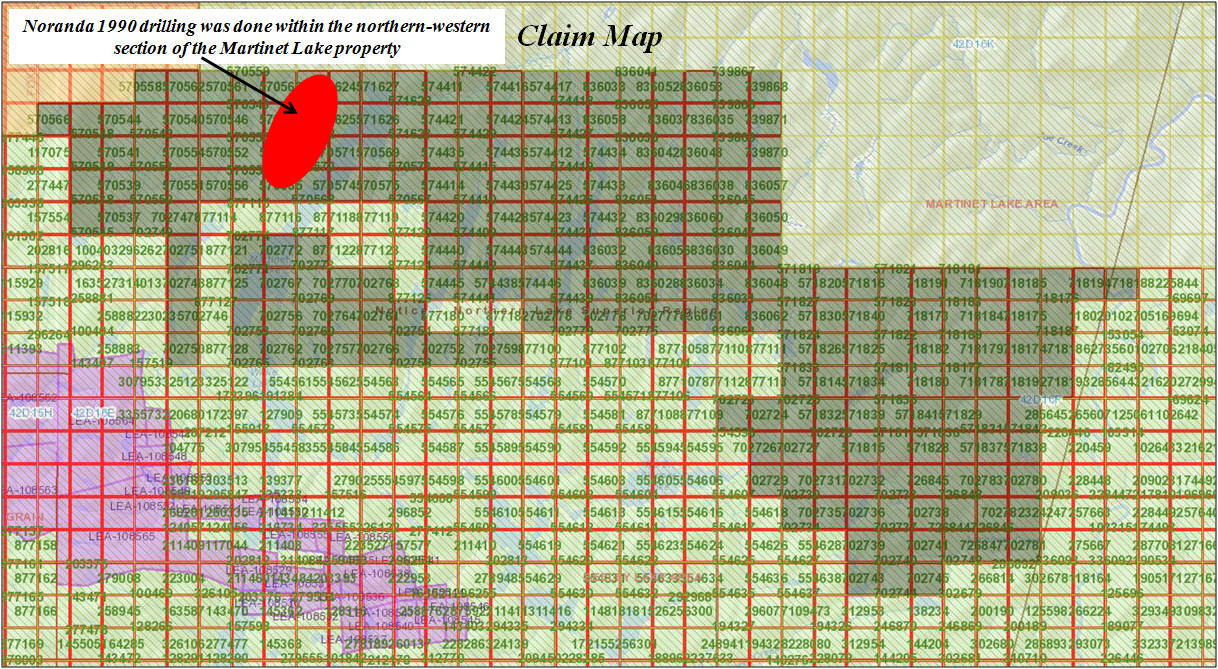
Diamond Drilling on the Martinet Jim Lake property in 1990
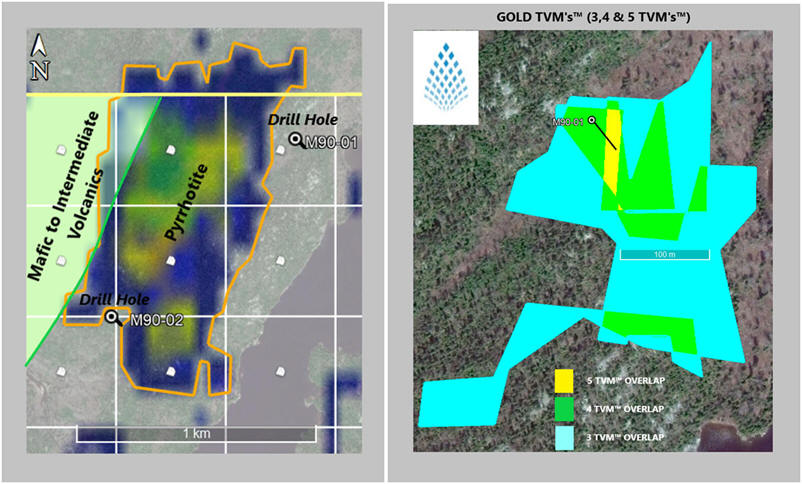

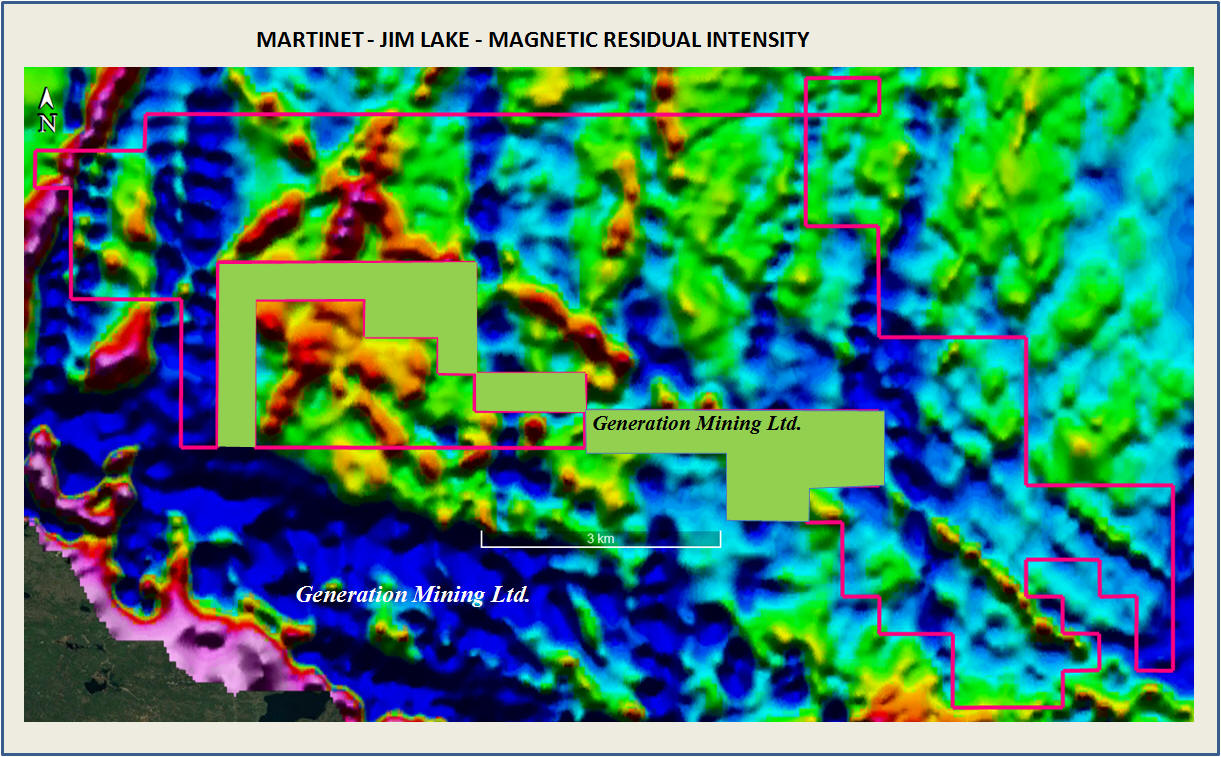
Aster Satellite LWIR Mapping Survey
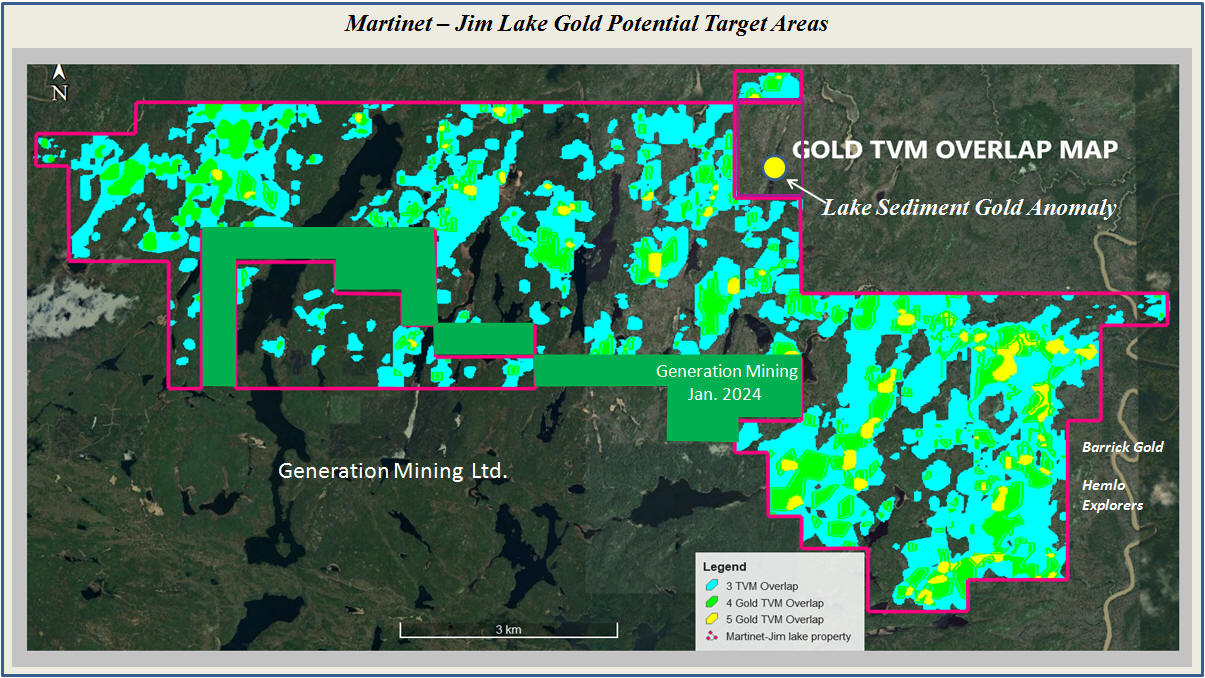
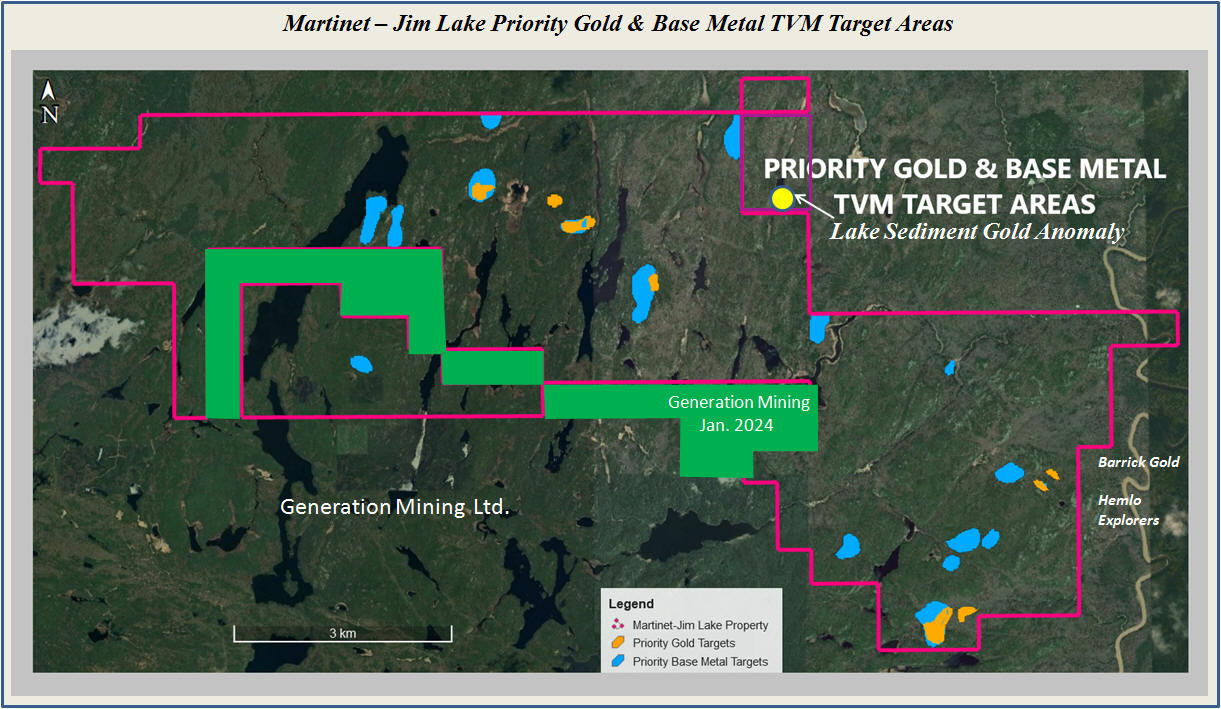
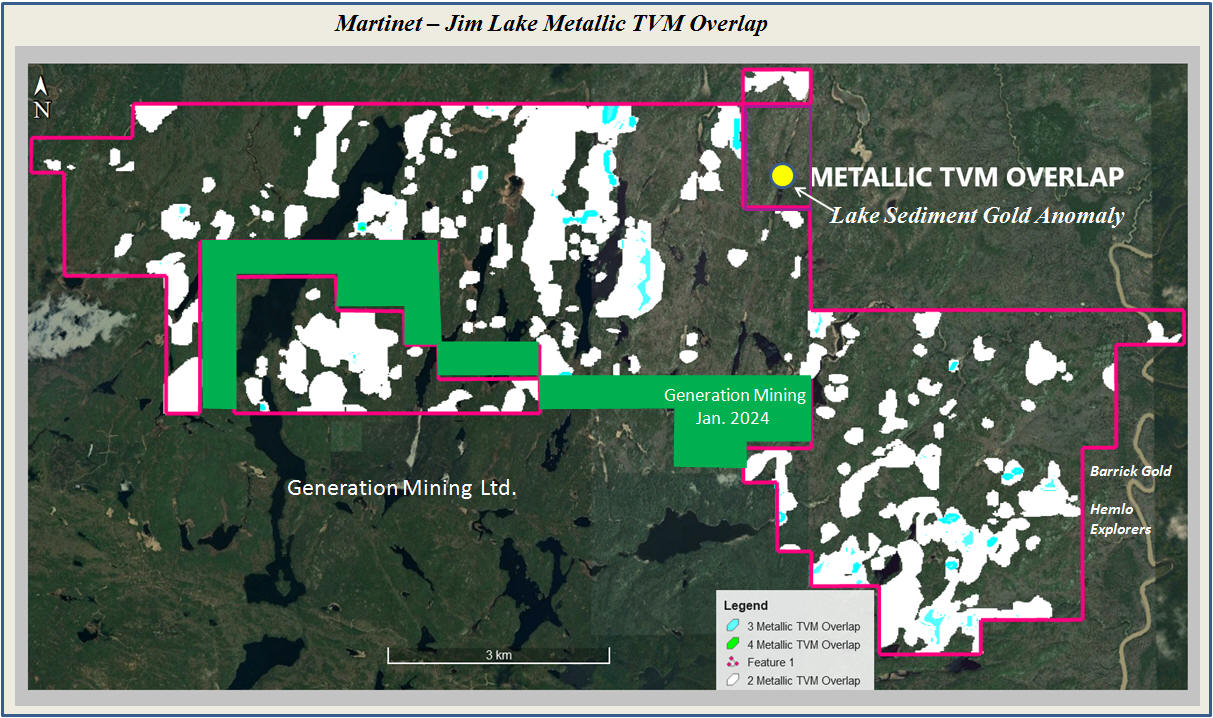
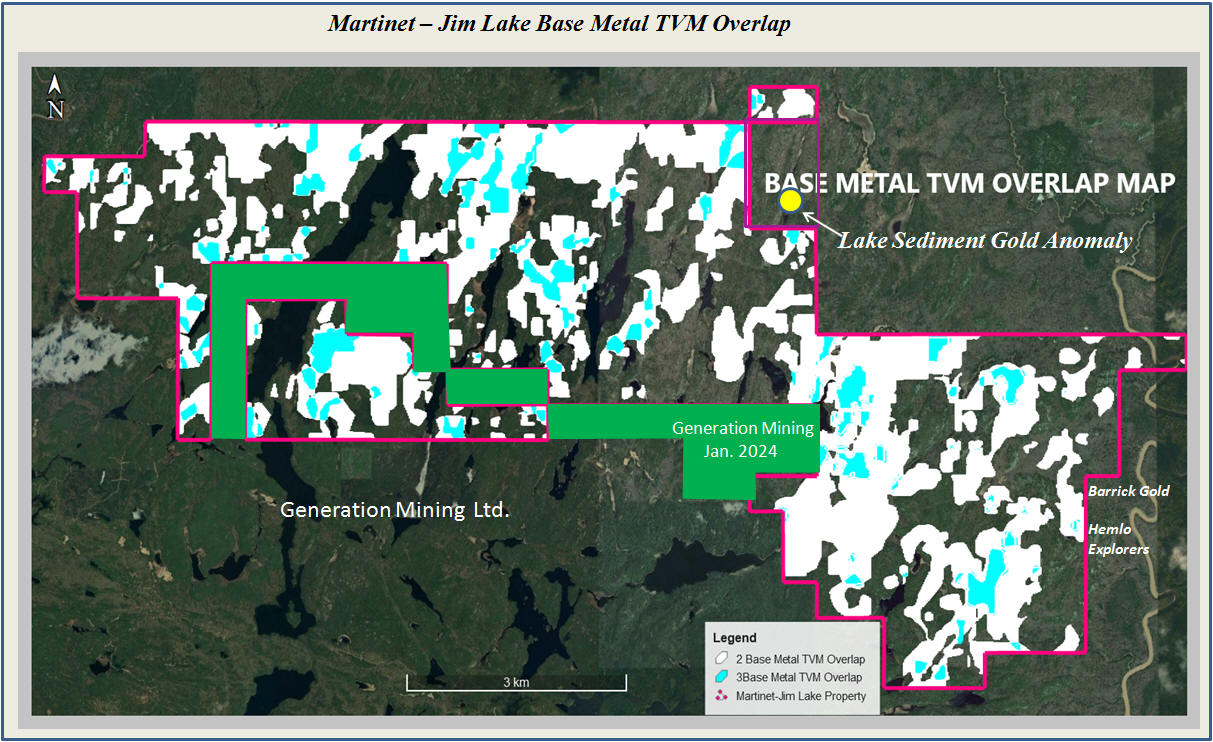
|
Aster Satellite LWIR Mapping Survey Results February 2022
Ontario Geological Survey digital records (geology, geophysics, historic and operating mines, mineral occurrences; drilling Etc.) in combination with the ASTER dataset makes an invaluable tool for exploration in the area and may assist in ground selection for future exploration on the property. The Aster Satellite LWIR Mapping survey results in indentifying a number of targets for exploration within the property. Site visits and ground inspection are required to further evaluate and interpret the data generated.
Aster Funds Ltd. Information at https://www.asterfunds.com/spectral-analysis
Aster Funds provides a low-cost mineral exploration technology that enables one to perform early-stage exploration via high-quality satellite imagery analysis to produce quick results. Invaluable for mineral claims acquisition and exploration work assessment filings. Aster Funds Ltd. Spectral Analysis Overview Advanced Spaceborne Thermal Emission and Reflection Radiometer (ASTER) ASTER is a Japanese electronic imaging sensor on board NASA’s multinational Terra satellite, launched into Earth orbit in 1999. The ASTER sensor has been collecting data since February 2000. Aster Funds adapted proprietary algorithms to filter out vegetation and cloud cover that interfere with the spectral signal. Detailed images are produced that outline 16 of the most abundant end members that are correlated to minerals that are present over the survey area. An additional 300 minerals can be identified and scanned for. Images outline mineral occurrences at surface with a pixel resolution of 90 metres. Target Vector Minerals (TVM™) are identified from spatial association with known mineralization in the survey area and TVM™ overlaps are used to outline exploration targets.
Synthetic Aperture Radar ⮚ Aster Funds produces synthetic aperture radar (SAR) surveys that mimic traditional airborne electromagnetic methods (EM). ⮚ SAR outlines electrical conductors at shallow depth. ⮚ SAR identifies issues with tailings dam safety.
Benefits ⮚Quick, Low-Cost Mineral Reconnaissance ⮚ Initial results highlight the 16 most abundant minerals on the property. ⮚ Able to identify up to a further 300 minerals. ⮚ Any property size can be surveyed. ⮚ Accurately outlines bodies of water. ⮚ Delivers geophysical results similar to surveys performed via airborne EM at a lower cost. ⮚ Fast results, in four to eight weeks. ⮚ Simplifies the Entire Claims Process ⮚ Aster Funds’ data is invaluable for planning exploration and claims acquisition. ⮚ View mineral abundances on your property and adjacent areas. ⮚ Anonymous and confidential. ⮚ No government permitting required. ⮚ No third-party stakeholder consultations involved. ⮚ No helicopters, pilots, standby time or need for good flying weather. ⮚ No mining or exploration consultants required. ⮚ Data is shared with your Qualified Person. ⮚ Valid for claims assessment work filings.
Sustainability Aster Funds Ltd highly values sustainability. We believe in preserving and protecting the earth’s fragile ecosystems for future generations. That’s why we've embedded it into our company’s sustainable mining framework. Our digital remote sensing and TVM (Target Vector Minerals) technology provides our clients with a reduced area for exploration, thereby minimizing unnecessary land and ecosystem disturbance, pollution, greenhouse gas emissions, and overall human impact on the environment.
|
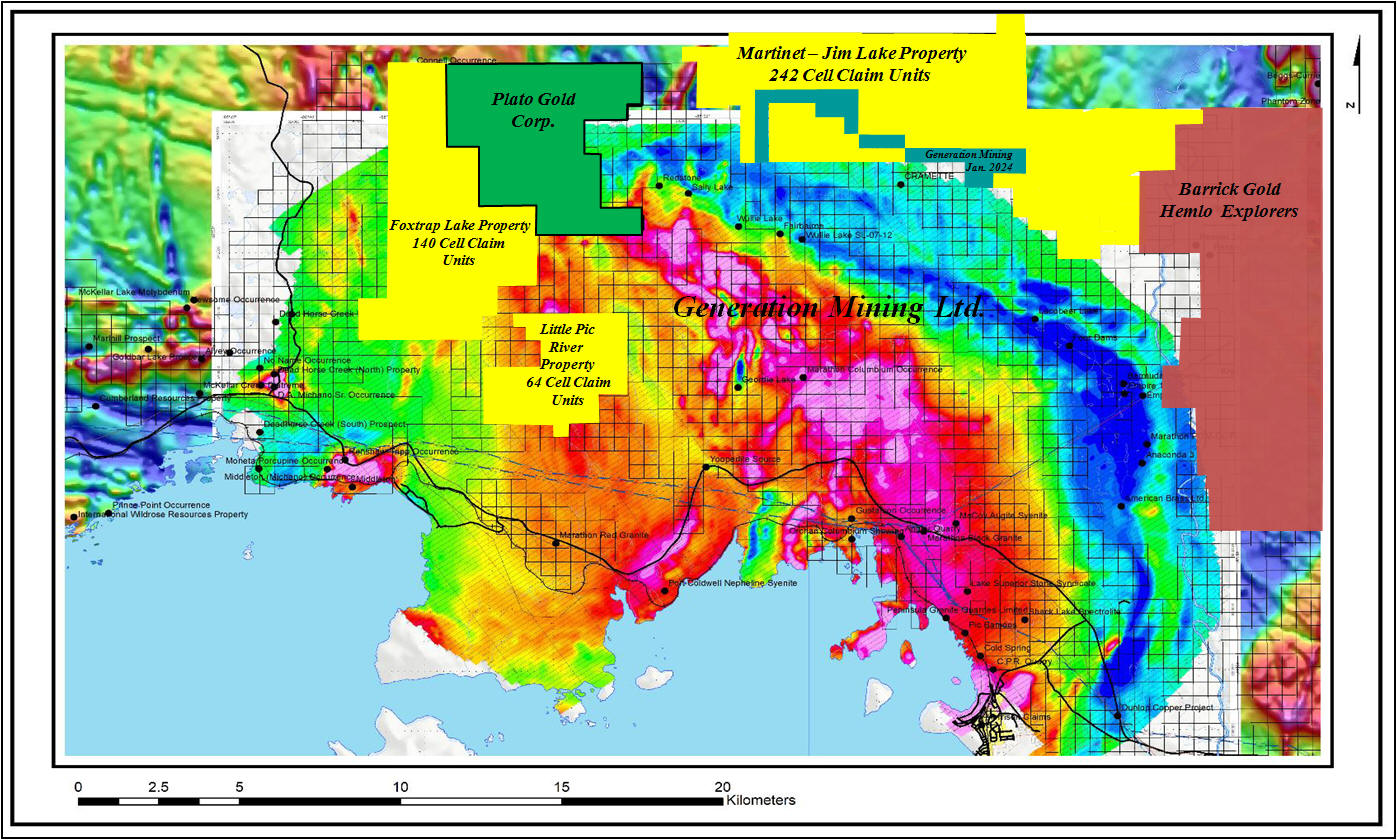
|
GEOLOGICAL SETTING AND MINERALIZATION
The Martinet Jim Lake Property is located at the eastern end of the Western Schreiber-Hemlo Greenstone Belt, which is part of the Wawa-Abitibi Terrane (WAT) of the Superior Province in Ontario. Rocks within this terrane across the province, share similar lithological, geochemical and age characteristics, and structural and metamorphic histories (Stott et al. 2010). The WAT is a typical Archean greenstone-granite terrane consisting of primitive ultramafic to felsic volcanic rocks and associated metasedimentary rocks, intruded, and enclosed by granitoid rocks. It is bounded in the north by the Quetico metasedimentary basin or subprovince (Magnus 2019, Stott 2011). The WAT contains a series of greenstone belts of similar age (ca. 2.95 to 2.68 Ga) hosting gold, nickel, and zinc deposits. In Northwestern Ontario, these deposits include the Hemlo Gold Mine at Marathon (located approximately 55 km east of the Martinet Jim Lake Property) and past producers; the Geco VMS (Cu-Zn) Mine at Manitouwadge, the Shebandowan Ni-Cu Mine and the Winston-Pick Lake VMS Zn-Cu Mine north of Schreiber.
Figure 4. Proterozoic Geology, Lake Superior Region (Modified after Gignac et al. 2021, from Generation Mining Limited Feasibility Study Technical Report, March 23, 2021
The center and southern portion of the Martinet Jim Lake Property straddles the boundary between rocks of the much older Archean Schreiber-Hemlo Greenstone belt and the younger Proterozoic Coldwell Complex Intrusion at between 1108 and 1094 Ma (Heaman and Machado, 1992 and Heaman et al., 2007) (Figure 4). The sub-circular Coldwell Complex (CC) has a diameter of 25 km and a surface area of 580 km2 and is the largest alkaline intrusive complex in North America (Walker et al. 1993). As part of the CC, the Eastern Gabbro occupies the northern and eastern margin of the complex and is host to Generation Mining Limited’s Marathon Pd-Cu Deposit (Figure 5). The company completed a Feasibility Study in March of 2021 and the deposit currently hosts a Proven and Probable Mineral Reserve Estimate of 2.34 Moz Pd @ 0.619 g/t, 532 Mlb Cu @ 0.205%, 255,000 oz Au, 756,000 oz Pt and 5.33 Moz Ag (Gignac et al. 2021).
Figure 5. Geology of the Coldwell Complex (Modified after Walker et al. 1993, from Marathon PGM Corp. 2010)
|
|
EXPLORATION HISTORY
The mineral potential of the Marathon area is considered high, based on the increased global demand for mineral resources together with extensive exploration activity in the Coldwell Complex and surrounding Schreiber-Hemlo Greenstone Belt. Most of the recent mineral exploration in the Coldwell Complex has focused on Cu-PGM+/-Au mineralization hosted in the peripheral gabbro ring of the Coldwell Complex. Gabbroic rocks occur continuously over a 20 km distance along the eastern and northern margins of the Coldwell Complex. Additionally, smaller portions of gabbro occur within the central Coldwell Complex and discontinuously along the southwestern margin (Good and Crocket 1994). Occurrences of rare metal (Nb, U, Zr, Th, and rare earth elements), building stone, industrial minerals and semi-precious gemstones occur within the syenitic rocks throughout the Coldwell Complex (Walker et al. 2021). Generation Mining is developing the 82.6%-owned Marathon Palladium-Copper project North of Marathon. A 2021 Feasibility Study shows a 30% Internal Rate of Return, a $1.07 billion NPV (6%) and a 2.3-year payback at a US$1725 palladium and US$3.20 copper price (Gignac et al. 2021). The Marathon deposit is the largest undeveloped palladium project in North America. A large percentage of the palladium mined today is used in automobile catalytic converters, which scrub toxic emissions from exhaust to control air pollution.
1993: Marathon PGM Corporation and Benton Resources Inc. controlled significant mineral exploration projects along the eastern and northeastern margin of the Coldwell Complex. Also during this period, other exploration companies were actively exploring the Archean metavolcanic rocks immediately surrounding the Coldwell Complex for gold and base metal deposits. They included: (i) Pelangio Mines Incorporated; (ii) Benton Resources Inc.; (iii) Phoenix Matachewan Mines Limited; and (iv) MetalCORP Limited. Additionally, local prospectors conducted work on key properties within the Coldwell Complex and in the surrounding greenstone belt.
2007: Marathon PGM controlled the most advanced Cu-PGM+Au project within the Coldwell Complex. Mineralization occurs in the Two Duck Lake Gabbro, located on the eastern margin of the Coldwell Complex. During this period, the company completed a diamond drilling program consisting of 180 holes totaling 40,000 m (Marathon PGM Corporation, news release, October 24, 2007). Results from a fence of drill holes (M-07-403, 405, 406, 410, & 417) collared outside the western margin of the known resource at the time, intersected wide intervals of mineralization up to 120 m, grading 0.97 g/t PGM+Au and 0.35% Cu (ibid). Resource estimates completed in early 2007, by P&E Mining Consultants Incorporated for Marathon PGM, reported a Measured Resource of 39.2 Mt containing 1.6 Moz of PGM+Au and 285 Mlb of Cu and Indicated Resource of 28.9 Mt containing 1.1 Moz of PGM+Au and 178 Mlb of Cu (NI 43-101 compliant). Benton Resources Bermuda property was located along the northwest strike extension of the Marathon PGM deposit. The company completed 66 diamond drill holes totaling close to 10,000 m, covering a strike length of 15 km. Highlights from drill holes BO-07-48 and BO-07-54, returned assays grading up 1.91 g/t PGM, 0.31% Cu over 33 m and 2.19 g/t PGM, 0.31% Cu over 23.5m respectively (Benton Resources Inc., news release, September 10, 2007). In the central portion of the Coldwell Complex, L.E.H. Ventures Incorporated reported a resource from four mineralized zones within the Geordie Lake Pd-Cu Property. In 2002 independent consultants for the company, Giroux and Stanley Consultants, estimated an Indicated Resource of 24.4 Mt averaging 0.326% Cu, 0.537 g Pd/t, 0.007% Co, 0.011% Ni, 0.030 g Pt/t, 2.52 g Ag/t and 0.04 g Au/t and an Inferred Resource of 5.4 Mt averaging 0.36% Cu, 0.626 g Pd/t, 0.007% Co, 0.012% Ni, 0.04 g Pt/t, 3.04 g Ag/t and 0.05 g Au/t (NI 43-101 compliant). E.C. Walker et al (1993) of the Ontario Geological Survey (OGS), in Open File Report 5868, Precambrian Geology of the Coldwell Alkalic Complex, reported several other Cu-PGE occurrences hosted by gabbro in the central and western portion of the Coldwell Complex. The Willie Lake occurrence located in the northern central portion of the Coldwell Complex returned grades up to 1.42% Cu over 6 m, reported from 1962-63 drilling by Head of the Lakes Iron Mine Ltd. Along the western margin of the Coldwell Complex, grab samples collected by Walker’s field crew returned copper grades up to 0.70% (1993, p.4). Additionally, Walker reported four types of rare metal (Nb, U, Zr, Th, and rare earth elements) occurrences found in pegmatite’s associated with amphibole syenite. Nepheline syenite, an industrial mineral product, was targeted for extraction during the 1950s to 1970s at three locations within the Coldwell Complex: Red Sucker Cove, Port Coldwell and Pic Island. Other notable rare metal and rare earth element occurrences are located within the Dead Horse Creek and McKellar Diatremes in the western metamorphic-contact-aureole of the Coldwell Complex (Sage, 1982, 1987, 1995). Smyk et al. (1993) of the OGS reported assays ranging up to 11.6% Zr, 0.6% Be, 2.5% Th, 250 ppm Sc, 1850 ppm Y, 300 ppm Nb, 903 to 1004 ppm and 4600 ppm U.
|